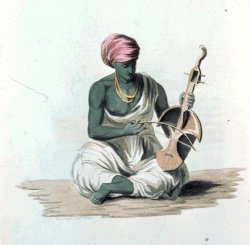
Religious music is a type of music that is performed or composed for religious use or through religious influence. It may overlap with ritual music, which is music, sacred or not, performed or composed for or as ritual. Religious songs have been described as a source of strength, as well as a means of easing pain, improving one's mood, and assisting in the discovery of meaning in one's suffering. While style and genre vary broadly across traditions, religious groups still share a variety of musical practices and techniques.
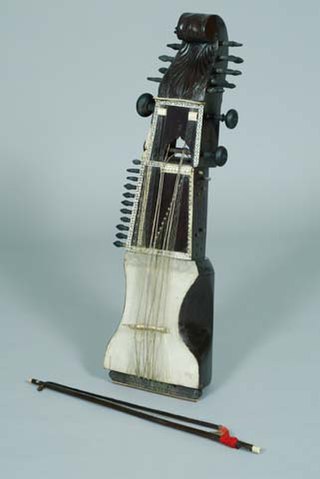
The sārangī is a bowed, short-necked three-stringed instrument played in traditional music from South Asia – Punjabi folk music, Rajasthani folk music, Sindhi folk music and Boro folk music – in Pakistan, South India and Bangladesh. It is said to most resemble the sound of the human voice through its ability to imitate vocal ornaments such as Gamaks or Gamakam (shakes) and meends. The Nepali sarangi is similar but is a folk instrument, unornate and four-stringed.

Music of Punjab reflects the traditions of the Punjab region of the Indian subcontinent, associated with Punjabi language. Punjab is currently divided into two parts: East Punjab, in India, and West Punjab, the most populous province of Pakistan. The Punjab has diverse styles of music, ranging from folk and Sufi to classical, notably the Patiala gharana. Contemporary Punjabi music has tended to include more modern hip-hop and R&B sounds. While this style of music is obviously most popular in Punjab, it has seen popularity across the subcontinent and areas with large Punjabi diaspora populations, such as Canada, the United Kingdom, and the United States.
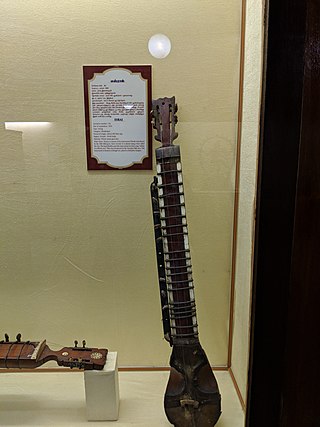
The esraj or esraaj is an Indian stringed instrument found in two forms throughout the Indian subcontinent. It is a relatively recent instrument, being only about 300 years old. It is found in Pakistan and North India, primarily Punjab, where it is used in Sikh music, and West Bengal where it is used in Rabindra Sangeet and Hindustani Classical Music. The esraj is a modern variant of the dilruba, differing slightly in structure.

The Seni rebab, also known as the Seniya rabab is a plucked string instrument used in northern India that is said to have been developed by, and to have taken its name from, the notable musician Tansen in the time of the emperor Akbar the Great. It has "a large hook at the back of its head, making it easier for a musician to sling it over the shoulder and play it even while walking." It has been used in Hindustani classical music and religiously, in Sikh music. The rebab influenced the development of the sarod, another Indian musical instrument.

Sikh music, also known as Gurbani Sangeet , and as Gurmat Sangeet, or even as Shabad Kirtan, is the classical music style that is practised within Sikhism. It exists in institutional, popular, and folk traditions, forms, and varieties. Three types of Sikh musicians are rababis, ragis, and dhadhis. Sikh music exists in various melodic modes, musical forms, styles, musicians, and performance contexts.

Rubab, Robab, or Rabab is a lute-like musical instrument.The rubab is the national musical instrument of Afghanistan, is also commonly played in Pakistan and India mostly by Pashtuns and Balochis, Sindhis, Kashmiris and Punjabis. Variants of the rubab include the Kabuli rebab of Afghanistan, the Rawap of Xinjiang, the Pamiri rubab of Tajikistan and the seni rebab of northern India. The instrument and its variants spread throughout West, Central, South and Southeast Asia. The Kabuli rebab from Afghanistan derives its name from the Arabic rebab and is played with a bow while in Central Asia and the Indian subcontinent, the instrument is plucked and is distinctly different in construction.
Bundu Khan was a Pakistani musical instrument sarangi player.

The Gandarbha caste or Gaine are a tribal community which belongs to the Indo-Aryan ethnic group from the central, hilly region of Nepal. They have also been called a "caste of professional musicians" and "itinerant bards." By tradition they make their living by singing Gandarbha Geet or Gaine Geet, a type of folk song. The Gandarbhas traditionally work as travelling musicians and play traditional folk and historical songs. They improvise songs too, incorporating news into them as a service, in return for which they receive donations of food or other things. They use the Nepali sarangi, a type of violin, as their main musical instrument. The sarangi has been an iconic musical instrument identified with the Gandarbha people. The instrument has replaced another instrument they played, the aarbajo, which was larger and "more cumbersome."

The dilruba is a bowed musical instrument originating in India. It is a type of Bowed Sitar that's slightly larger than an esraj and has a larger, square resonance box like a sarangi. The dilruba holds particular importance in Sikh history.
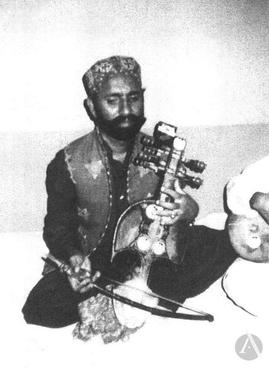
The suroz is a bowed string instrument with a long neck, similar to a fiddle or sarangi and played vertically. It is considered the traditional instrument of the Baloch people in Balochistan.

The Nepali Sarangi is a Nepali folk instrument. It is a chordophone played by bowing. Traditionally in Nepal, the Sarangi was only played by people of Gandarbha or Gaine caste, who sing narrative tales and folk song, however, in present days, its popularity extends beyond the Gandharba community and is widely used and played by other caste members as well. It has also garnered much interest in other music genres, such as Nepali rock and film music. While the Sarangi has become the quintessential Gandharba instrument, its counterpart, the arbajo, which is a plucked lute, has fallen into obscurity.

The taus, originally known as the mayuri veena, is a bowed string instrument from North India. It is a form of veena used in North India with a peacock-shaped resonator called a mayuri, and is played with the neck of the instrument on bow. Some versions have Sympathetic Strings that go to the Headstock like a Dilruba so they're known as the Mayuri Dilruba.

The chikara is a bowed stringed musical instrument from India used to play Indian folk music. It is used by the tribal people of Rajasthan, Madhya Pradesh and Uttar Pradesh.
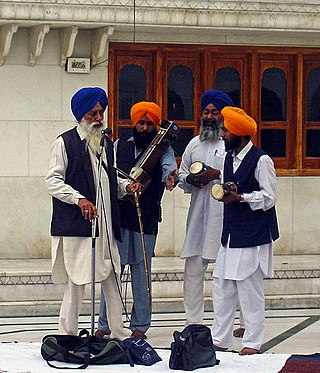
Dhadi, also spelled as Dhadhi, is one who sings ballads using Dhadd and Sarangi, the folk instruments of Punjab. According to Kahn Singh Nabha's Mahan Kosh the definition of dhadhi is "One who sings ballads of warriors playing Dhadd". Dhadis are a distinct group performers emerged in the time of Sikh gurus.

The arbajo is a Nepali four-string lute used as a rhythm instrument. It is the traditional instrument of the Gandarbha caste of musical performers, and is considered a companion to the Nepali sarangi. The Gandarbhas consider the aarbajo to be the "male instrument", the sarangi the "female." The aarbajo is used less than in the past, and been replaced by the sarangi, which was considered in 1999 to have superseded the aarbajo in common use.

Punjabi folk music is the traditional music on the traditional musical instruments of the Punjab region of the Indian subcontinent. There is a great repertoire of music from the time of birth through the different stages of joy and sorrow till death. The folk music invokes the traditions as well as the hardworking nature, bravery and many more things that the people of Punjab get from its gateway-to-India geographical location. Due to the large area with many sub-regions, the folk music has minor lingual differences but invokes the same feelings. The sub-regions, Malwa, Doaba, Majha, Pothohar, and hills areas, have numerous folk songs. Punjabi dance OP Bhangra music which is a genre of Punjabi modern music invented in Britain by the Punjabi diaspora.
Munir Sarhadi was a Pashtun-Pakistani instrumentalist, sarinda player and a folk singer. As a musician, he represented Pakistan in several countries. In 1978, Munir became the recipient of Pride of Performance, a civil award conferred by the Government of Pakistan.
Indus Blues is a 2018 Pakistani documentary film produced and directed by filmmaker Jawad Sharif. The film is about the dying folk and classical musical instruments of Pakistan and the struggle of musicians and craftsmen to keep their art alive. The film was premiered in August 2018 at Regina International Film Festival in Canada and nominated for the Best International Documentary Film Award. The official trailer was released in October 2018 in Pakistan.
